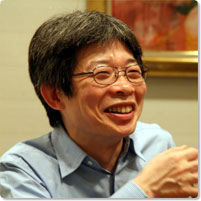Data
:
First Performance: 1989
Performance time: 1 hour 30 minutes
Acts / Scenes: 4 scenes
Cast: 18 (7 men, 11 women)
*Plans call for a Japanese version of
Oriza Hirata
Citizens of Seoul

Oriza Hirata
Born in Tokyo in 1962, Oriza Hirata is a playwright and director and the leader of the theater company Seinendan. He is also the artistic director of the Komaba Agora Theater in Tokyo and artistic director of Kinosaki International Arts Center. He is a specially appointed professor of the Organization for COI at the National University of the Arts, Tokyo, a visiting professor and special counsel to the president of Shikoku Gakuin University, a visiting professor at the Kyoto Bunkyo University, he is president of the Theater Professional Conference of the Japan Performing Arts Foundation, manager of the Fujimi Municipal Hall Kirari Fujimi, a director of the Japanese Society for Theatre Research, a director of the Japan Foundation for Regional Art Activities, a cultural policy advisor for Toyooka City, and a director of the Nagi Town Education, Culture and Community Development committee.
At the age of 16 Hirata took a leave from high school and set off to travel around the world by bicycle, eventually riding through 26 countries worldwide over the course of 18 months. In 1984, he graduated from the Liberal Arts School of the International Christian University in Tokyo. During his time at the university he formed the Seinendan theater company. In his Junior year at the university, Hirata got a scholarship to study abroad at South Korea’s Yonsei University for one year.
He won the 39th Kishida Kunio Drama Award for playwriting with Tokyo Notes in 1995, after which he won many prizes up until 2019, when he won the 22nd Tsuruya Nanboku Drama Award for History of the Rise and Fall of Japanese Literature . In 2006, he won the Montblanc de la Culture Arts Patronage Award. In 2011, he was awarded the L’Ordre des Arts et des Letters of the French Ministry of Culture.
Oriza Hirata has been one of the key figures in the contemporary theater scene in Japan with his “contemporary colloquial theater theory.” He has actively undertaken many collaborative productions abroad, in countries including France, South Korea, China. From 2008 to 2013, he served as chairman of the Japanese committee for the BeSeTo theater festival. Also, at his public small-theater Komaba Agora Theater he has pursued the education and nurturing of young theater makers. He has also achieved notable achievements in the areas of communication education through theater and theater instruction at the university level. Through his activities as artistic director at public theaters and publications like his book Geijutsu Rikkoku Ron (Arts as the Basis of a Nation, 2002) and other efforts, he has remained an opinion leader in the field of public policy concerning the arts and culture at the national and local government levels.
Seinendan website:
http://www.seinendan.org/eng/
The play opens in the summer of 1909 at the SHINOZAKI family’s residence. The second Mrs. SHINOZAKI, who came from Japan after getting married to Mr. SHINOZAKI some years ago, cannot get used to life in Korea. The son doesn’t have any idea what he wants to do with himself. The daughter devotes her time to literature. Nobody knows what the continental adventurers and houseboys are up to – probably nothing. The maids keep on jabbering about trifles. Various visitors call.
Time in this house passes, seemingly disconnected from the turbulent world outside. Through their low-key conversations, become apparent the sins of citizens without malice (such as subconscious discrimination), who take for granted their own superiority.
Hirata named this piece
Citizens of Seoul
after James Joyce’s collection of short stories,
The Dubliners
, whose Japanese title is literally “Citizens of Dublin.” Just as Joyce depicted the Dublin people under British rule in
The Dubliners
, Hirata aimed at depicting the streams of consciousness of the SHINOZAKIs and presenting their lives and the age in which they lived. Consisting of exchanges among such citizens, this piece enables the audiences to have a rich, meaningful experience as when one reads a full-length novel.
Citizens of Seoul
has been translated into Korean, English, and French. The French translation by Rose-Marie Makino-Fayolle (
Gens de Seoul
) is published by Les Solitaires Intempestifs. Oriza Hirata wrote and directed
Citizens of Seoul
, 1919, a sequel, in 2000.
*Plans call for a Japanese version of Citizens of Seoul directed by Frederic Fisbach to be performed at the Setagaya Public Theatre in Tokyo in December of 2005. Fisbach has been selected as the associate artist for the 2007 Avignon Festival with his works to be performed there. Also, a French-language version of Citizens of Seoul is scheduled to be performed at the Theatre National de Chaillot in October of 2006 directed by Arnaud Meunier.
Related Tags

